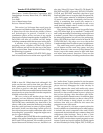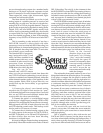measured by Cirrus Logic with an “A-weighted” filter.
That kind of weighting is applied by placing a filter
before the noise meter. The filter is said to allow the
measurement to better reflect how the ear perceives
noise level changes, meaning less sensitivity at the high
and low end. Weighting also makes DAC noise
performance look better since some noise has been
filtered away. However, it really has no application
here, since a properly designed DAC should have a
flat noise floor, although cheap DACs can have an
increase in noise at the low end. This is a sign of a
design compromise that we do not want hidden under
an A-weighted rug.
Even when no weighting is used, the DAC in this
player has a little more than 17-bit resolution.
Distortion at -20 dB input level is a little better than 18
bits typical. At full scale it drops back to 16.5 bits.
Worst-case, full-scale distortion is slightly below 16
bits. These distortion numbers are for 1 kHz. The
numbers usually get worse at higher frequencies, but
the data sheet does not list distortion results at higher
frequencies. The decline of the ENOBs with increasing
input signal level frequency at full scale is one of the
key benchmark tests for evaluating the usefulness of
a general purpose DAC in a particular application
space. For an application specific chip like the CS4382,
the information sometimes does not make it to the data
sheet.
That said, Cirrus supplies almost all other dynamic
specification about this chip, whereas data sheets for
chips that do not perform as well, but are likely less
expensive, may contain no worst-case numbers, and
numbers without A weighting will not be listed by
manufacturers. Providing more detail on the data sheet
shows the company has confidence in the design’s
ability to deliver these numbers when the devices are
mass produced.
How many bits of noise level headroom do we
need? Well that depends on how quiet your room is
and the maximum loudness you will tolerate in that
room. (This is the all-digital-ones level of the CD – the
largest signal level the DAC can reproduce.)
Of course, other components in one’s audio system
must also have noise specs as good the DA converters.
Most home electronics will not hack it, since a
maximum signal to noise ratio of 110 dB is the
equivalent of 18 bits. And of course the recordings
must also have been created with very low microphone
noise. In addition, they must have low noise in the
analog signal path that follows the microphone (analog
level adjustment and equalization may sometimes be
used in the production of a modern CD), have low
noise in the studio or concert hall, and also have
sufficiently low A/D converter noise.
Data in conference and journals have presented
information that points to 18-bit equivalent signal-to-
noise levels as the required minimum for a professional
studio (designed for very low background noise,
which may only be achieved with special construction
techniques and materials). I do not recall the maximum
signal level (all ones) was used for the tests but I
assume it was at least movie theater level loud.
With respect to distortion, again we must consider
the rest of the equipment in the system. Almost all of
you have seen THD vs. level graphs and will recall
they rise as the level gets higher. At higher signal
levels, more nonlinear effects of the electronics are
uncovered. This is true with the DAC as well as analog
components. In most cases the power amp will
dominate a systems-distortion level at maximum
signal level – the point where the power amp is about
to clip, which in a digital system should be set to
correspond to the all ones digital representation of the
loudest signal level on a CD. Only the very best power
amps could match this Cirrus converter’s distortion
level at its worst-case distortion specification.
Before we get too excited, please recall the DAC
in a DVD player is only in use in SACD or DVD-A
modes when the analog pass-through of your AV
receiver is active. In this mode, all the good things your
AV receiver can do (advanced digital bass
management, multi-band EQ, multi-channel synthesis
etc) are bypassed. When playing normal CDs (via the
digital hookups to the receiver and not the analog
outputs) and DVDs, it is the DA converters in the AV
receiver that count and not the one in the player.
This Cirrus chip has a balanced output, and this is
found only on the better converters and requires more
analog electronics. The digital filter preceding the DAC
is a complex design providing a digital frequency
response of +/-0.01 dB and a 90-dB stop band for
digital signals at a 44.1kHz sample rate. Although the
+/-0.01 dB spec noted in the Cirrus info sheet may
look silly, it is an important indicator of FIR filter tap
length, and it correlates with the very important stop
band attenuation. The best chips are +/-0.002 dB with
more than 100 dB of stop-band rejection. The CS4382
chip has a true DSD inputs for the SACD disks.
However, I cannot tell whether it passes it through to
the analog output directly or turns it first into PCM,
in which case any advantage of SACD signals having
no digital signal processing is rendered moot. The data
sheet is unclear—in one section on the frequency
response of the chip I find the heading “Combined
digital and on chip analog filter response -DSD mode.”
The chip also has a slow-roll-off mode that trades
stop-band attenuation for improved group delay
flatness in the passband (improved by a factor of 3).
In the 44-kHz mode the slow rolloff starts slightly in-
band, at 18.3 kHz instead of 20 kHz. Both fast and slow
rolloff modes bring the signal level down 3 dB at 21.9
kHz. More significant is the change in the rejection of
the 20 kHz first-folding tone that results in the
reconstruction process of the sampled signal (24 kHz










